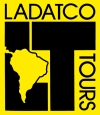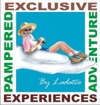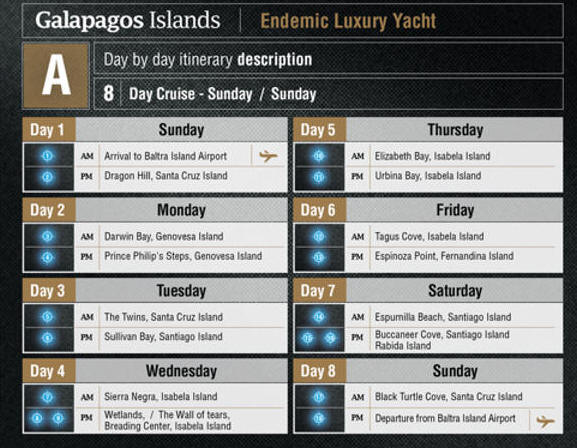

Destinations
Experiences
 |
L A
D A T C O T O U R
S |
 |
||||||||
| HOME | South America | Falkland Islands | Antarctica | Unique Destinations |
Unique Experiences |
Newsstand | ||||
|
|
Itinerary A
|
|
|
 |
DAY 1 - SUNDAY
BALTRA AIRPORT – Dragon HillUpon arrival at the airport, you will be greeted by your guide and transported from Baltra Airport to the M/C Endemic.
At Dragon Hill walk on the island and view land iguanas. Be among these magnificent reptiles, that just a few decades ago were on the brink of extinction.
Located on the north-western part of Santa Cruz island, Dragon Hill offers the opportunity to also see a flamingos’ lagoon, pintail ducks and other endemic birds including flycatchers and warblers. After a short trek, amazing view awaits us up the hill. Offshore snorkeling before returning to the yacht.
(L, B)
DAY 2 - MONDAY
GENOVESA – DARWIN BAY- BARRANCO
Darwin Bay is the only sandy beach found in the caldera on Genovesa. Colonies of the Great Frigatebirds are found along the beach. Males exhibit their red balloon pouch to females for hope of a match. Red-footed boobies nest in the trees in contrast to the other two booby species which do so on the ground.
Across Darwin Bay is El Barranco (Prince Philip’s Steps), a set of stairs carved out of stone. This will lead you to a wide plateau, where you can observe large colonies of masked boobies, frigatebirds, storm petrels and ducks. During this easy stroll you will cross a small Scalesia forest, habitat of the short-eared owl. The same path will lead you back to your boat.
(B, L, D)
DAY 3 - TUESDAY
TWIN CRATERS – SULLIVAN BAY
Located in the highlands of Santa Cruz on the road to Baltra airport from Puerto Ayora, the scenic Twin Craters are approximately 30 meters deep. These two huge land depressions are surrounded by a scalesia forest with abundant birds such as yellow warbler and the vermilion flycatcher. Gorgeous views of the leafy green highlands forest are also part of the visit. Then we will continue our journey to board the M/C Endemic.
SULLIVAN BAY
In the afternoon, you will visit Sullivan Bay on the east coast of Santiago Island. We land on a white coral sand beach and begin our walk over lava that flowed less than 100 years ago. This is the perfect place to see and feel the volcanic origin of Galapagos. Also in this area you will admire flora that grows in lava fields.
(B, L, D)
DAY 4 - WEDNESDAY
SIERRA NEGRA VOLCANO – WETLANDS – WALL OF TEARS – BREEDING CENTER
Isabela Island is the largest of the archipelago with a surface of 4588 sq.km. It encompasses more than the half of the total land area of Galapagos. Sierra Negra Volcano is one of largest craters in the archipelago with a diameter of five kilometers. It offers mesmerizing views with great contrast in colors between lava fields, vegetation and fumaroles.
Humedales (The Wetlands) are a complex of trails of 6 kilometers long, located south of Isabela Island. They have a wide variety of flora and abundant bird life, including gallinules, finches, stilts and ducks among others. On the way up to Orchilla hill, giant tortoises and marine iguanas will appear. From the viewpoint the spectacular scenery of the bay, the town of Puerto Villamil, volcanoes, islets and rocks can be appreciated. Isabela wetlands has endemic and introduced species.
You will also visit the Wall of Tears. This is a man-made monument which has been built in the 1940’s by prisoners, since Isabela island was once an Ecuadorian penal colony and building up the wall was part of the punishment.
Finally, at the Arnaldo Tupiza Breeding Center of Isabela, infant and juvenile giant tortoises can be seen until they are ready to be released and survive in the wild. On the way back to the yacht, be ready to spot flamingos and other water birds.
(B, L, D)
DAY 5 - THURSDAY
ELIZABETH BAY – URBINA BAYElizabeth Bay is a marine visitor site so the excursion is carried out in a zodiac and so there is no landing point. Your zodiac ride starts with a visit to the Marielas Islets where there is the largest and most important penguin colony in the Galapagos Islands. The excursion continues into the cove that is surrounded by red mangroves where you can spot sea turtles, flightless cormorants, spotted eagle rays, golden rays, brown pelicans and sea lions.
During a visit at Urbina Bay you can see coral formations, large colored land iguanas and the possibility of seeing giant turtles, flightless cormorants, blue-footed boobies, penguins and marine iguanas is excellent.
(B, L, D)
DAY 6 - FRIDAY
TAGUS COVE - ESPINOZA POINT
A ride along the cliffs in a zodiac will give visitors a good chance to see the Galapagos penguin, the flightless cormorant and other sea birds. From the landing dock it is about a 30-minute hike along the trail up to the top of the cliff from where you can view Darwin Lake, a saline lake saltier than the sea. You can also see several volcanoes from this location.
Espinoza point, one of Fernandina’s visit points, is situated within a fascinating lava scenery with Lava-Cactuses and on the surface of the lava, mangroves thrive. The highlights are sea lions, penguins, the flightless cormorant (especially in spring and summer) and one of the biggest iguana colonies of Galápagos.
(B, L, D)
DAY 7 - SATURDAY
ESPUMILLA BEACH – CALETA BUCANERO – RABIDA
Espumilla Beach is a pristine sandy beach and a popular place for marine iguanas and Sally lightfoot crabs. The crabs attract the hunting herons, performing a dance of predator and prey. With an abundance of marine life including octopi, moray eel, and shark, snorkeling is recommended with your included snorkel gear.
Just north of James Bay is Buccaneer Cove which was known as a safe haven in the 17th and 18th century for pirates to stash their loot, take on freshwater, and capture tortoises for food. It is nice place for a zodiac ride, snorkeling and kayaking. Blue-footed, Nazca boobys, fur seals, and Galapagos hawks can be seen flying overhead.
Rabida Island’s main attraction is the red sand beach, famous for its cactus groves and rock formation scenery, aside from the vegetation of the arid zone and the presence of native and endemic species. During the walk on the red sand beach you will see brown pelican nests and a lagoon where flamingos are seen from time to time.
(B, L, D)
DAY 8 - SUNDAY
BLACK TURTLE COVE – BALTRA AIRPORT
Located on the north shore of Santa Cruz, is a living illustration of how mangroves alter the marine environment to create a rich and unique habitat. Three mangrove species crowd the area from the shore out into the lagoon, which reaches almost a mile inland.
As we drift through quiet waters in our zodiac, we are likely to see spotted eagle rays and diamond shaped mustard rays, which swim in a diamond formation. White-tipped reef sharks slip beneath the boat and Pacific green sea turtles come to the surface for air and to mate. Waterfowl, including pelicans, herons and egret, all feed in the cove.
Bus ride from the M/C Endemic to Baltra airport for your return flight to mainland Ecuador.
Assistance and farewell at the airport.(B)
*The operator reserves the right to change the itinerary without previous notice due to weather, National Park regulations or notifications and unforeseeable circumstances.